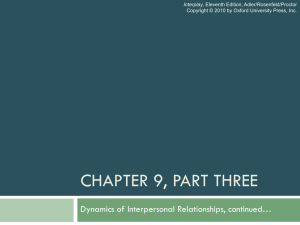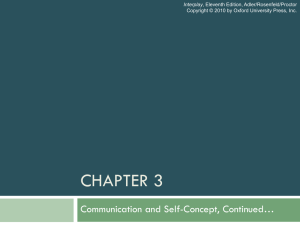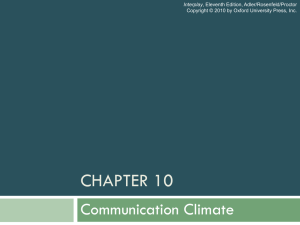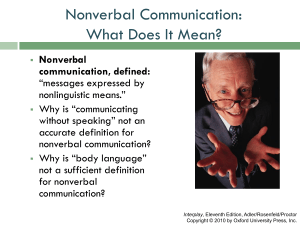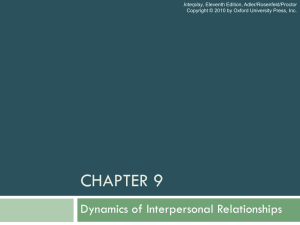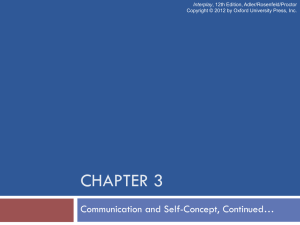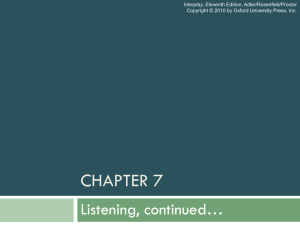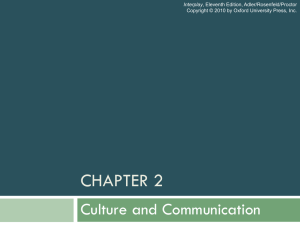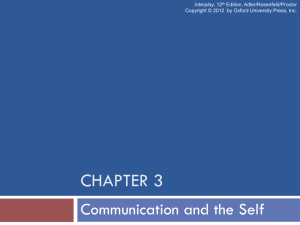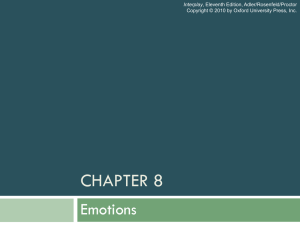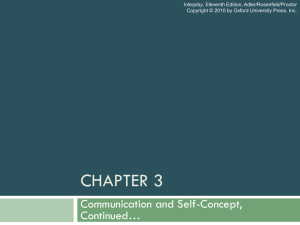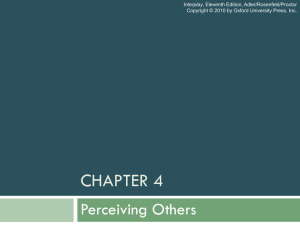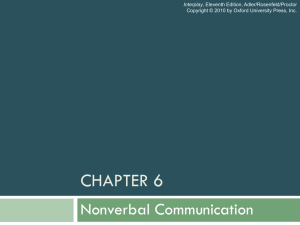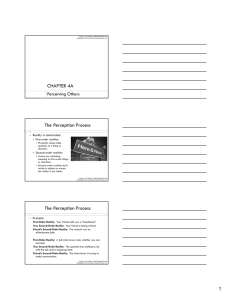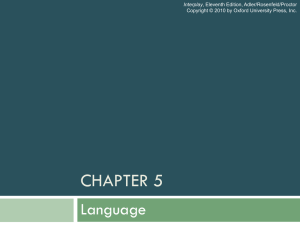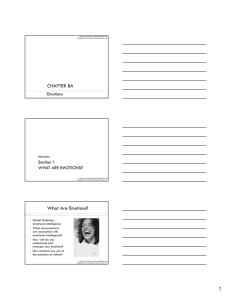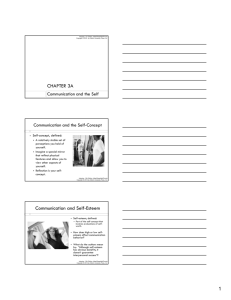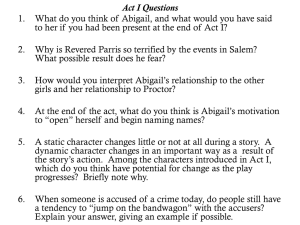Ch09b_Interplay11 - Forensicconsultation.org
advertisement
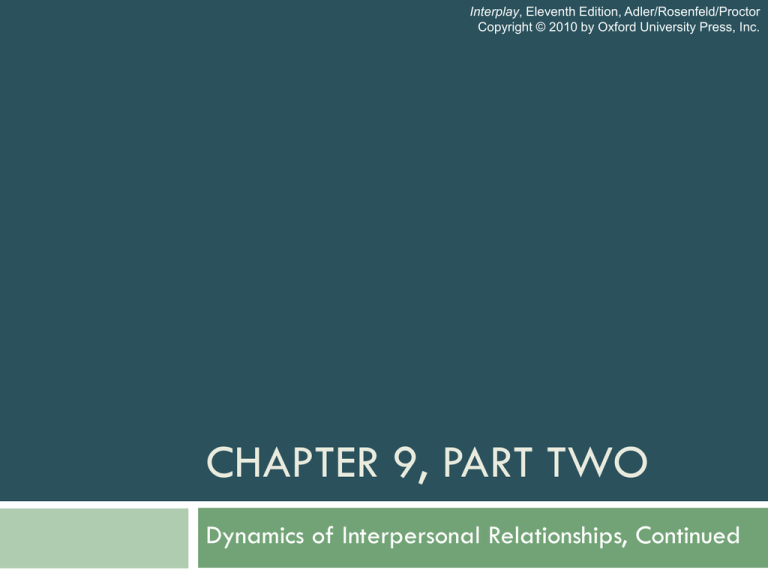
Interplay, Eleventh Edition, Adler/Rosenfeld/Proctor Copyright © 2010 by Oxford University Press, Inc. CHAPTER 9, PART TWO Dynamics of Interpersonal Relationships, Continued Interplay Section 2 COMMUNICATION AND RELATIONAL DYNAMICS Interplay, Eleventh Edition, Adler/Rosenfeld/Proctor Copyright © 2010 by Oxford University Press, Inc. Developmental Models of Interpersonal Relationships Mark Knapp: 10 step model. Other research: coming together, coming apart, and relational maintenance. Interplay, Eleventh Edition, Adler/Rosenfeld/Proctor Copyright © 2010 by Oxford University Press, Inc. Knapp’s Model: Initiating Stage You are interested in making contact. You demonstrate that you are a person worth talking to. Superficial stage. Difficult stage for shy people. Interplay, Eleventh Edition, Adler/Rosenfeld/Proctor Copyright © 2010 by Oxford University Press, Inc. Knapp’s Model: Experimenting Stage Search for common ground. Small talk. Useful way to learn about shared interests Allows for “auditioning” Safe way to ease into a relationship Provides a link to others Information at this stage depends on the nature of relationship we seek. Interplay, Eleventh Edition, Adler/Rosenfeld/Proctor Copyright © 2010 by Oxford University Press, Inc. Knapp’s Model: Intensifying Stage Where qualitatively interpersonal relationships develop. Friendship: Shared activities; romantic relationships: express feelings directly, ask for support, give tokens of affection. Relational excitement and euphoria! Stage doesn’t last forever. Interplay, Eleventh Edition, Adler/Rosenfeld/Proctor Copyright © 2010 by Oxford University Press, Inc. Knapp’s Model: Integrating Stage Identity as a social unit. Social circles merge. Common property is designated. Partners develop routines and rituals. Sense of obligation grows. Requests are straightforward; expectations heightened. Uncertainty decreases, which enhances attraction and closeness. Interplay, Eleventh Edition, Adler/Rosenfeld/Proctor Copyright © 2010 by Oxford University Press, Inc. Knapp’s Model: Bonding Stage Symbolic public gestures to show the world that the relationship exists. Engagement Sharing residence Written or verbal pledge. Relationships don’t have to be romantic to achieve bonding. Important turning point. Interplay, Eleventh Edition, Adler/Rosenfeld/Proctor Copyright © 2010 by Oxford University Press, Inc. Knapp’s Model: Differentiating Stage Re-establishment of individual identities. First, inevitable feelings of stress. Normal part of relational maintenance—key is maintaining commitment while creating space for individuality. Interplay, Eleventh Edition, Adler/Rosenfeld/Proctor Copyright © 2010 by Oxford University Press, Inc. Knapp’s Model: Circumscribing Stage Communication decreases in quantity and quality. Subtle hint of dissatisfaction grow more evident. Suppression of true relationship status. Restrictions and restraints occur. Dynamic communication becomes static. Interplay, Eleventh Edition, Adler/Rosenfeld/Proctor Copyright © 2010 by Oxford University Press, Inc. Knapp’s Model: Stagnating Stage Relationship: Hollow shell of its former self. Couples are unenthusiastic, have no sense of joy or novelty. Stagnation occurs when workers lose job satisfaction, but remain. Interplay, Eleventh Edition, Adler/Rosenfeld/Proctor Copyright © 2010 by Oxford University Press, Inc. Knapp’s Model: Avoiding Stage Distance is created, directly or indirectly. Expressing detachment—avoiding the other person altogether. Avoiding involvement—ignoring, no touching, superficial politeness. Showing antagonism—behaving in a hostile way; treating the other person as “lesser.” Mentally dissociate—thinking about the other person as less capable, unimportant. Vicious cycle develops. Interplay, Eleventh Edition, Adler/Rosenfeld/Proctor Copyright © 2010 by Oxford University Press, Inc. Knapp’s Model: Terminating Stage Summary dialogues of where the relationship has gone; desire to dissociate. Can be short or drawn out. Research: Friendship before relationship can be predictor of friendship after relationship. Termination is a learning experience. Interplay, Eleventh Edition, Adler/Rosenfeld/Proctor Copyright © 2010 by Oxford University Press, Inc. Interplay Section 3 LIMITS OF DEVELOPMENTAL MODELS Interplay, Eleventh Edition, Adler/Rosenfeld/Proctor Copyright © 2010 by Oxford University Press, Inc. Limits of Developmental Models Communication ebbs and flows in relationships. Progression does not always flow in a predictable manner. Knapp’s model: A relationship exhibits only the most dominant traits of just one of the 10 stages at any given time, but elements of other stages are usually present. Relationships can “come together” and “come apart” at the same time. Interplay, Eleventh Edition, Adler/Rosenfeld/Proctor Copyright © 2010 by Oxford University Press, Inc. Dialectical Perspectives on Relational Dynamics Dialectical tensions: Conflicts that arise when two opposing or incompatible forces exist simultaneously. Dialectical forces that make successful communication challenging: Integration-separation dialect Connection-autonomy dialect This dialectic is one of the most significant factors affecting a relationship. Inclusion-seclusion dialect Interplay, Eleventh Edition, Adler/Rosenfeld/Proctor Copyright © 2010 by Oxford University Press, Inc. Dialectical Perspectives on Relational Dynamics Stability-change dialect Predictability-novelty dialect Conventionalityuniqueness dialect Expression-privacy dialect Openness-closeness dialect Revelation-concealment dialect Interplay, Eleventh Edition, Adler/Rosenfeld/Proctor Copyright © 2010 by Oxford University Press, Inc. Strategies for Managing Dialectical Tensions Denial Balance Disorientation Integration Alternation Recalibration Segmentation Reaffirmation Interplay, Eleventh Edition, Adler/Rosenfeld/Proctor Copyright © 2010 by Oxford University Press, Inc. Interplay END OF SECTION CHAPTER CONTINUES IN PART THREE Interplay, Eleventh Edition, Adler/Rosenfeld/Proctor Copyright © 2010 by Oxford University Press, Inc.
